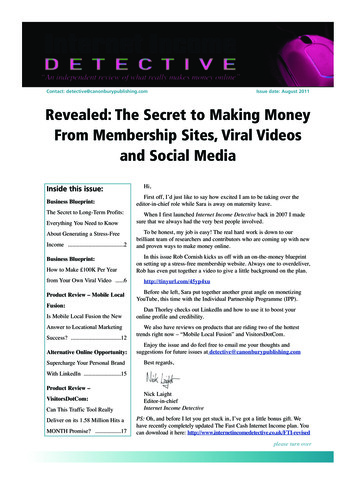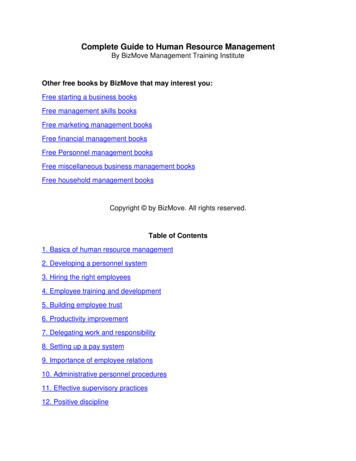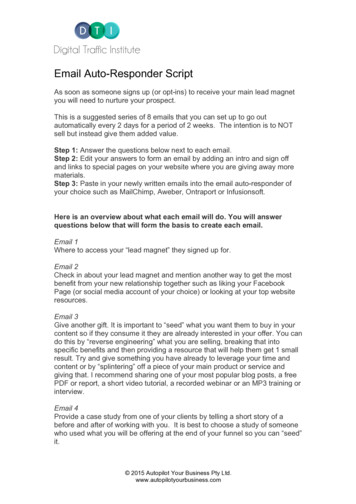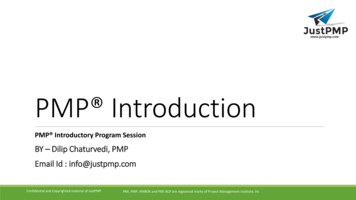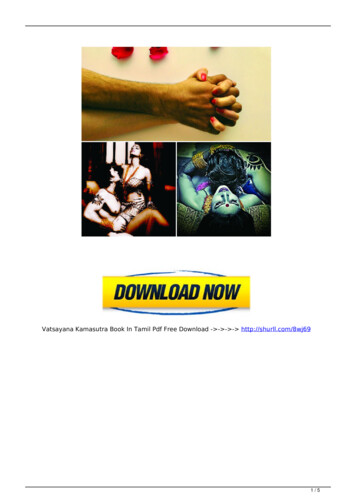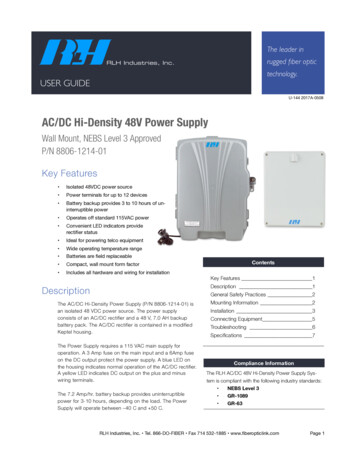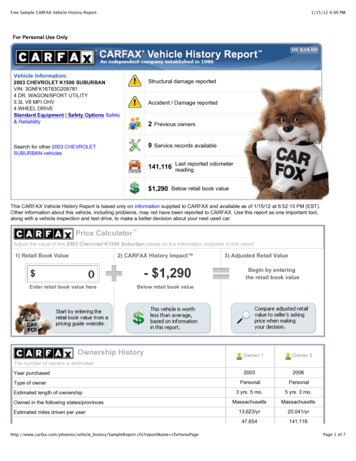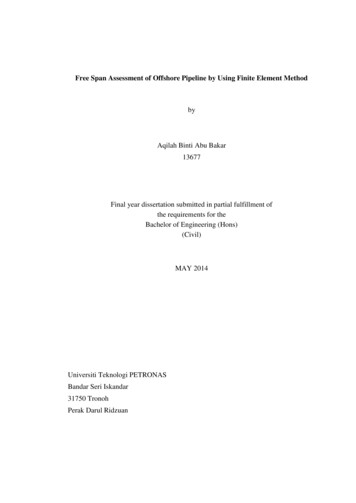
Transcription
fieldguidetoemailmarketingTABLE OF CONTENTSAbout the Fourth Edition .2HOW HTML EMAIL WORKS.4The Multipart/Alternative MIME format .4Image Files in HTML email.4Delivering HTML email .5DESIGNING AND CODING .7Design guidelines .8CSS in HTML email .10ANATOMY OF A GOOD HTML EMAIL NEWSLETTER.13Plain-text email .15COMMON MISTAKES TO AVOID .17DESIGNING AROUND SPAM FILTERS.20How anti-spam systems work .20Tactics for avoiding spam filters.23TESTING AND TROUBLESHOOTING YOUR EMAIL DESIGNS .25Testing in browser-based email services .28EMAIL MARKETING BASICS AND BEST PRACTICES.32The Definition of Spam.32Royal Screw-ups to avoid .33Double opt-in .37MEASURING PERFORMANCE .38Open rates.38Click rates.39Unsubscribe rates, bouncebacks .40Traffic to your website .41Signups since last campaign.42WRAPPING UP .43Checklist: Your first email campign .43RESOURCES .47
HELLO.You don’t have to be a professional web designer to use this guide,but a little HTML knowledge will help. First, we’ll cover all the basics,like how HTML email works (and why it always seems to break whenyou try to send it yourself). Then we’ll get into the technical stuff, likehow to design and code your HTML email. Finally, we’ll run throughemail-marketing best practices for list management, deliverability andmeasuring performance.If any of your questions aren’t addressed here, feel free to contact oursupport staff at mailchimp.com/support. We’ll be happy to assist you.About the Fourth EditionAccording to our server logs, this guide has been downloaded a fewhundred thousand times since we first wrote it in 2001. We hope it’shelped a few people out there get their email marketing off to a goodstart.We wrote the first edition because back then, you had to know a lot oftechnical stuff before you could get into email marketing. Emailmarketers were jacks-of-all-trades—designing their emails, codingthem into HTML, setting tracking links and images, managing bouncesand setting up databases on their websites.Nowadays, email-marketing services like MailChimp have built-in toolsthat do all that tedious stuff for you. We manage your lists, give yousignup forms, send welcome emails, handle double-opt-ins, set oneclick unsubscribe links—and we even give you built-in HTML emailtemplates (so you don’t have to know how to code HTML emailanymore). Our new features include Design Genius, a tool that helpsyou create emails that match your company’s brand, and geo-location,so you can reach your subscribers anywhere in the world, right ontime. All you have to do now is create excellent content and click“send.” In other words, a lot of the technical “how-to” stuff in thisguide has been replaced with “push this button in MailChimp.”But there are new challenges, which we’ll cover in this fourth edition: Most email programs now block all images in your HTML emailby default. You’ve probably noticed how you have to right-clickon an email or push some button to make images show up inthe emails you receive. We’ll help you design around that. Over the years, desktop email programs (like Outlook, Lotus,Eudora and Apple Mail) made great progress in standardizing2
the way they display HTML email. But then webmail services(like Yahoo, Gmail, and Hotmail) started getting more popular,and they have their own unique challenges. Two steps forward,one step back. We’ll share what works and what doesn’t inwebmail clients. Then, Microsoft decided to change therendering engine in Outlook 2007 from Internet Explorer toMicrosoft Word. Again, two steps forward, one step back. Spam filters are very sensitive to the content in your email.We’ve got tips on how to write your content. There’s so much spam out there, that spam filters need theirown spam filters now. They’re called firewalls or gateways, andthey block email before they even get to your recipients’ spamfilters, based on reputation. We’ll teach you how to protect yourreputation. Spam laws require every email marketer to follow some veryimportant rules. If you break any of the rules, you can get yourpants sued off. We’ll let you know what information you mustinclude in each email you send to your customers. Blacklists used to simply block email based on the server yousent from. Now, they scan the content of your messages andlook for domain names that have been found in reported spam.Even if you’ve never sent an email campaign before, you canfind yourself on a blacklist if one of your reseller partners hasbeen sending spam with your domain name in it. We’ve got tipsfor staying away from blacklists.But first, what the heck is MailChimp?MailChimp makes it easy to design and send beautiful emails, manageyour subscribers and track your campaign’s performance. We takefancy-schmancy tools like segmentation, a/b testing and ROI tracking,and we turn them into something anyone can use.Looking for stats on who’s opening and clicking your emails? You gotit. Wanna integrate your campaigns with Facebook, Twitter or Flickr?No problem. Need help choosing colors that match your website? Weautomated that. Why? Because email marketing shouldn’t be a hassle.The information in this guide comes from years of research andexperience in the email-marketing world (and it doesn’t hurt that wesend a gazillion emails a day).3
HOW HTML EMAIL WORKSBefore you can start designing, coding and sending HTML email, youneed to know how it works and what tools you’ll need. Here’s somebackground information that every email designer and marketershould know.The Multipart/Alternative MIME formatThe most important thing to know about HTML email is that you can’tjust attach an HTML file and a bunch of images to a message and click“send.” Most of the time, your recipients’ email applications will breakall the paths to your image files by moving your images into temporaryfolders on your hard drive. And you can’t just paste all your code intoyour email application, either. Most email apps send messages inplain-text format by default, so the HTML won’t render. Yourrecipients would just see all that raw source code, instead of the prettyemail that’s supposed to show up.You need to send HTML email from your server in MultipartAlternative MIME format. Basically, that means your mail transferagent bundles your HTML code, plus a plain-text version of themessage, together into one email. That way, if a recipient can’t viewyour beautiful HTML email, the good-old-fashioned plain-text versionof your message is automagically displayed. It’s kind of a nerdygobbledy-geek thing, which is why a lot of people mess it up whenthey try to send HTML email themselves. You either need to program ascript to send email in multipart-alternative MIME format, or just usean outside vendor (ahem, like MailChimp) to deliver email for you.Image files in HTML emailEmbedding images and photos into messages is the #1 reason peoplewant to send HTML email. The proper way to handle images in HTMLemail is to host them on a web server, then pull them into your HTMLemail, using absolute paths in your code. Basically, you can’t send thegraphics along with your message. You host the graphics on a webserver, and then the code in your HTML email downloads themwhenever the message is opened. Incidentally, that’s how opentracking works. You place a tiny, invisible graphic into the email, andthen track when it’s downloaded. This is why open tracking only worksin HTML email—not plain-text—and why the new email applicationsthat block images by default (to protect your privacy) can screw upopen-rate stats.4
TIP: CODING IMAGE TAGS IN HTML EMAILDo this: img src ” Instead of this: img src ”images/logo.gif” If you just use MailChimp’s built-in email designer, we host your graphicson our server for you—for free. No need to FTP files anywhere, or codeanything.Free hosting servicesYou really need your own server to host images for your HTML email.Don’t try hosting images on a free “image hosting service,” becausethose websites often put scripts in place to prevent you from linking tothem in emails (they can’t handle all the traffic). And since you getwhat you pay for in that regard, free image hosting services tend to bepretty unreliable under heavy traffic conditions. Also, spammers usefree image hosting services all the time to cover their tracks. Emailmarketing services like MailChimp have built-in image hostingcapabilities.Delivering HTML emailLots of newbies make the mistake of setting up forwarding lists, orCC’ing copies of a message to all their customers. This causes allkinds of problems—especially when a customer clicks “Reply to all.”First of all, there’s no way to do any kind of individual tracking orpersonalization when they CC a big group like that. Plus it just looksunprofessional and impersonal when recipients can see your entire listof other recipients.That’s why when an email-marketing system like MailChimp sendsyour campaign, we take your message and send it one at a time toeach recipient on your list (really, really fast). Unlike your workcomputer linked to your local ISP—which probably has a standardmonthly bandwidth limit—email-marketing vendors use dedicated mailservers that are capable of sending hundreds of thousands of emails(even millions, for larger vendors) per hour.Other factors you should consider when delivering HTML emailcampaigns:5
If you send from your own server: Your ISP may throttle youroutgoing emails or shut down your account if you send toomuch too fast (like more than 500 per hour) or if you exceedyour monthly bandwidth limit. If you’ve ever sent an emailcampaign to a big list of recipients, and you attached a giantPDF, this has probably happened to you before. Email firewalls and ISPs that receive your emails don’t likereceiving tons of emails from one single IP address at once(unless they normally receive tons of emails from that IP). So ifyou only send occasional email campaigns from your IP, youmay want to throttle your delivery or spread them acrossmultiple IPs, to avoid accidental blocking. Email-marketingservices usually split your campaign into pieces and send it outover lots of different IP addresses. If you send emails from your desktop email program, chancesare you’re connecting through your local ISP. If you don’t have adedicated IP address set up with your ISP, you’re probablysending emails from a dynamic IP address. ISPs and spam filtersdon’t like receiving lots of emails from a dynamic IP address,because it looks like a hijacked home computer. If you’re notusing an email-marketing vendor like MailChimp, you shouldalways send from a dedicated IP address.6
DESIGNING AND CODINGNow that you have a basic understanding of how HTML emailcampaigns work and how you should deliver them, let’s start talkingabout designing and coding them (the fun part!).Tools of the tradeHere are the tools you’ll need to succeed at coding HTML emails:1. A design application, like Adobe Photoshop, Fireworks,Dreamweaver or Illustrator. Use these tools to lay out your templateand slice out your graphics, like your company logo and productphotos. We’re partial to Fireworks, but to each his own.2. A good, pure HTML/Text editor, like BBEdit and TextWrangler forthe Mac, or HomeSite and NoteTab Pro for the PC. You could useWYSIWYG style tools to generate HTML, like Microsoft FrontPage, ormaybe Adobe GoLive or Macromedia Dreamweaver. But they have theirdisadvantages. WYSIWYGs very often throw in gobs of junk into yourcode (FYI, Microsoft says the extra code is to help with “roundtripping,” which means you can export from Word to Powerpoint toHTML, then back again, without losing anything). All this extra codeusually ends up just breaking things or setting off spam filters. Thereare some WYSIWYGs out there that generate clean code, but we’vefound those are a bit too perfect, because they’re designed for webpages and not HTML email (so they don’t know all the things you haveto rig in your code). If you want to do HTML email correctly, you shouldlearn to code HTML from scratch with a good text editor.TIP: FREE HTML EMAIL TEMPLATESIf all this talk of designing and coding HTML is too nerdy for you,consider using MailChimp’s built-in HTML email templates. They’resuper flexible and can be customized to match any brand. Plus,they’ve already been tested in all the major email programs. See somenice examples of what our customers have done:mailchimp.com/resources/templates3. Your own web server, to host all your images and archives. Youshould create a folder on your website for email newsletters. This iswhere you’ll store images, then point to them with absolute paths inyour HTML code. You might also want a folder on your website to storearchived newsletters. When we started out, we created a folder on our7
website called, /monkeywrench/ and then kept campaigns undersubfolders named by /date/ to store each campaign. Use your ownorganization style—just be sure to come up with a system and processfor archiving, so that each newsletter isn’t a chore to publish.Nowadays we don’t even bother, because we use MailChimp’s built-inarchive functionality. It’ll save a copy of every campaign you send fromour system. You can build a page on your website called “NewsletterArchives” and paste a little code snippet from MailChimp. We’ll keepyour page updated with your most recent campaigns. Saves so muchtime.4. An FTP program, like Fetch for the Mac, or CuteFTP for PCs. Whenyou design your email and slice out all your graphics, you’ll use FTP tomove those files from your computer to the server.5. A test machine (or two), loaded with as many different emailapplications and accounts as possible. You’ll want to check your HTMLemail designs under lots of different scenarios. Unlike web design,where you only have to check your work in a small handful ofbrowsers, there are tons of email applications out there, and they allhandle HTML email differently. If you use MailChimp, you can add onour Inbox Inspector tool (mailchimp.com/inboxinspector) to do all thetesting for you.Design guidelinesHere are some pointers for designing your email. Early warning: Ifyou’re a seasoned web designer, you won’t be happy with all thecompromises and hacks you’ll have to make when designing for emailapplications.Set your width to about 500-600 pixels.If you’ve ever worked on a website, you’re probably used to designingpages to fit 1024x768 screens. But that won’t work when you designHTML email. Most recipients will be looking at your email through theirpreview pane, which is usually a small portion of their availablescreen. A width less than 600 pixels is safe for most programs.TIP: THE 250 PIXEL BOXMost preview panes are so crowded, you really only have about 250pixels in height or width to make your first impression. Check out thisblog post for 0-pixel-box8
Simple layouts and tables work best.You wouldn’t believe all the different ways email applications garble upHTML email. Keep your email designs nice and simple. Avoidcomplicated layouts, too many embedded tables, and tables with toomany rows and columns. A simple two-column table with a row acrossthe top is about as complex as you can get. Lots of email applicationsdon’t cooperate when you code tables with colspans, which are tablecells that span across multiple columns. One application that’sparticularly finicky when it comes to tables (and just about everythingelse) is Lotus Notes.If you’re working on an email layout and find the tables are gettingcomplex, and you’re having to code too many colspans, you mightthink about chopping it up into separate tables. For instance, wealmost always use separate tables for the header, body and footer ofour emails. Better to go with more simple tables than one big complextable.If you’re a CSS ninja, you’re probably rolling your eyes in disdain withall this “tables” talk. But trust us—you’re not going to be able to use allthat cool, timesaving CSS stuff in your HTML emails. DIVs and CSSpositioning don’t work (we’ll cover that later in this guide).Special considerations for webmail servicesA lot of your recipients will check their email in their web browser,such as with Yahoo!Mail, Hotmail or Gmail. Since they’re viewing emailin browsers, there are certain things you need to know when you codeyour HTML emails: They’ll strip out your HTML , HEAD , and BODY tags, inorder to keep your code from interfering with their web pages.That means. Any background colors you specify in your BODY tag will belost. So wrap your entire email inside a larger, 100% wide table,and set a background color to that table. Any CSS that you place inside the HEAD tags will be lost. Sodon’t try to link to CSS files hosted on your server. Useembedded CSS instead, and make sure it’s below the BODY tag. If you’re a web designer, that’ll make you feel kinda dirtybecause that’s not exactly the proper place to put embeddedCSS. But no worries—it’ll work. If you just can’t stomach that,use inline CSS. Some webmail clients are starting to strip even the most basic9
CSS, even if it’s embedded below the BODY tag (like wedescribed above). We think it’s because they don’t want any ofyour CSS interfering with their CSS, or maybe because they’reusing so much JavaScript and AJAX technology.TIP: EMAIL PROVIDER TRENDSWe analyzed outgoing email traffic from the MailChimp servers to seewho the major email providers are and to identify trends. Check outour rends-yahoo-and-hotmailtops-gmail-catchingCSS in HTML emailCSS (Cascading Style Sheets) is a godsend for websites, but don’t puttoo much faith in it with HTML email. For instance, you shouldn’texpect DIVs to work. And definitely stay away from CSS positioning.Won’t work. If you’re a CSS-standards freak, you’re going to hateyourself after coding HTML email. You’ll have to rely on old-fashioned TABLES for your layouts in HTML email, and only use CSS for simplefont formatting and colors. Always design your CSS to “fail gracefully.”That means if someone took away your CSS, your design and contentwould still display decently. Before you send your HTML email, deletethe CSS and see what it looks like. Did you have tiny text that is nowgigantic, and blowing out your tables?CSS is especially touchy if you’re using a WYSIWYG to design yourHTML email, because WYSIWYGs insert all kinds of crazy CSS and DIVsby default. It’s one of the drawbacks of WYSIWYGs for HTML email. Itmay help you get things coded, but you still have to understand HTMLenough to go back and remove some of the code, so things won’tbreak in email applications. You might as well code by hand.Using Microsoft Word to generate HTML is even worse than usingWYSIWYGs. Word adds so much code behind the scenes, it’sunbelievable. Don’t do it. Learn to code HTML, or use our built-inHTML email designer.If your email design uses lots of CSS, be sure to check it in Gmail. Atthe time of this writing, they don’t fully support CSS, so you’ll see yourfonts defaulting to Arial and black in color. Here’s what ourMonkeyWrench Newsletter looked like in Outlook (which supports CSSjust fine) vs. Gmail:10
Gmail stripped out virtually all of our CSS. Where did our font sizes andline height go?Flash, (and JavaScript, ActiveX, movies, and other stuff that won’twork) in HTML emailYou can deliver HTML emails with Flash in them, but most recipientswon’t be able to view them. Not unless they’re using an email programthat uses a browser to render their HTML email. Most anti-virusapplications block the code used to embed Flash movies, and theyblock JavaScript, ActiveX, and even background music files. All thatstuff has been used in the past to spread viruses, so it’s commonlyblocked now.There are services out there that claim to make videos work inside ofemails, but most of them seem to just be elaborate ways of pointingpeople to landing pages that recipients would view in their browser.We haven’t found any that reliably work inside an email reader.Goodmail provides a certification process where you can pay to haveyour videos work inside certain email programs. Visit goodmail.com toget the most updated list:If you must include rich media inside your emails, the safest solution isto use a landing page. For example, if you’ve got a great animation ormovie to show to your recipients, just send a simple, intriguing GIF orJPEG graphic in your HTML email, then link it to a landing page on yourwebsite with the animation in it. Same goes for JavaScript, ActiveX andmovie files. Anti-virus applications block them from running. So fancyrollover or pop-up navigation and streaming videos aren’t going towork either. MailChimp’s video merge tags handle all that for you.11
TIP: VIDEO MERGE TAGSMailChimp’s video merge tags can save you a lot of time if you want toinclude videos in your email campaigns. Check them out -and-vimeo-inmailchimpBackground colorsRemember when we told you about how browser-based email services(like Yahoo!Mail and Hotmail) strip out your HTML , HEAD , and BODY tags? That’s what you need to remember when coding yourbackground colors and images. You normally specify that stuff in your BODY tag, but you can’t rely on that with HTML email. You’ll needto create a big, 100% wide table wrap around your email. Set yourbackground color in that table, and use some CELLPADDING asneeded. If you’re into CSS, you might be tempted to use a DIV instead. But we’ve seen DIVs break quite frequently in emailapplications, so we don’t recommend them.12
ANATOMY OF A GOOD HTMLEMAIL NEWSLETTERHere’s what a well-built HTML email newsletter looks like:ϭ͘&ƌĞĚĚŝĞ sŽŶ ŚŝŵƉĞŶŚĞŝŵĞƌϯ͘Ϯ͘ϱ͘ϰ͘ϲ͘13ϳ͘
1. Your company name in the “From” field. Recipients should recognizewho the email is from instantly. It can’t be deceptive in any way (duh).If a recipient has to strain his brain to remember who you are, he’llclick “This is spam” instead of opening.2. A relevant subject line (don’t be “spammy”), with your company ornewsletter name in it. So they instantly know who the email is from,and what it’s about (hence, subject line).3. The “To:” field of your email should be personalized to therecipient’s name, not their email address. MailChimp lets you mergerecipient names into this field, if you have it in your database. Youwould insert * FNAME * * LNAME *, for example. Check out our mergetag cheatsheet for more info: mailchimp.com/resources/merge4. A one-click opt-out link that removes people from your listimmediately. There are times when you might consider placing it at thetop of your email as well as in the footer, so that people who want offyour list can easily find it (instead of clicking their “Junk” button). Ifyou use MailChimp’s Managed List functionality, you would use our* UNSUB * tag to generate your unsubscribe link (it’s required in everyemail you send from our system). Any recipient who clicks it will beinstantly removed from your list. If you use our built-in HTML emailtemplates, we insert that link into the footer for you—no codingrequired.5. In addition to your opt-out link, you might also include a link inyour header for recipients to “View this email in your browser.” Point itto an archived version of your email on your server. This helps if theemail was forwarded to friends, and got mangled along the way.MailChimp automatically keeps an archived version of all yourcampaigns on our server. You can just use our * ARCHIVE * tag in youremails to link to yours. If you use our built-in HTML email templates,we automatically place this link at the top of all your emails.6. Your valid, physical mailing address, and as much contactinformation as possible. The more contact information you provide,the more reputable your email will look.7. Bonus: It’s a really good idea to also include some kind of remindertext, like “You are receiving this email because you signed up at ourwebsite.” People forget opting in to lists, and they get a little triggerhappy with the “This is spam” button. That can get you reported to themajor ISPs, so you want to prevent it. Also, in the rare case that arecipient reports you to an anti- spam organization, having thisreminder text can make the difference between a server adminblacklisting you forever, or contacting you for further explanation. Ifyou use our built-in email templates, MailChimp automatically insertsthat reminder text into your email footer with the merge tag:* LIST:DESCRIPTION *14
Plain-text emailDon’t forget your plain-text email. You need it for people who can’t (orwon’t) view HTML. Sometimes the plain-text version of your email isthe one that gets displayed if your recipient checks email on a mobiledevice. If you don’t take the time to create the plain-text version ofyour HTML email, you’ll just look like a lazy spammer (spam filters willpenalize you for only sending HTML). When you send a campaign inMailChimp, you’ll need to create both versions of your message (HTML& Plain-text). Then we bundle them together in multipart format andsend them off. Your recipients’ email applications decide which versionto display.The art of plain-text emailThere’s definitely an art to constructing your plain-text email. Youcan’t just use the same text from your HTML email. It has to beformatted juuuust right, so the best way to do it is to build it fromscratch, or copy-paste the content from your HTML email, thenreformat it heavily. Here are some tips for your plain-text emails:1. Use a plain text editor, like TextWrangler for the Mac, or WindowsNotePad. Don’t use something like Microsoft Word, because it won’tgive you the kind of raw text files you need. You need an applicationthat gives no formatting whatsoever.2. If you’re using MailChimp, just click the button that says Copy textfrom HTML version and we’ll take care of it for you. This will save yousome time, but you’ll almost always want to hand-tweak it to make itjust right.3. By default, some email applications start to wrap your plain-textmessages at about 60 characters or so. That’s not really a big deal tomost people. Just let your text wrap wherever their email programswant it to. But if you have content that you absolutely do not want towrap unexpectedly (like in the middle of a hyperlink), one nice littletrick is to type a letter 60 times across the top of your message, anduse that as your “ruler.” As your content approaches the end of thatruler, hit your return key and hard wrap the line. Again, this is only ifyou want very strict formatting. While you’re hard wrapping, make surenone of your lines begin with a period. A couple of periods used toindicate the end of
what you pay for in that regard, free image hosting services tend to be pretty unreliable under heavy traffic conditions. Also, spammers use free image hosting services all the time to cover their tracks. Email-marketing services like MailChimp have built-in image hos

